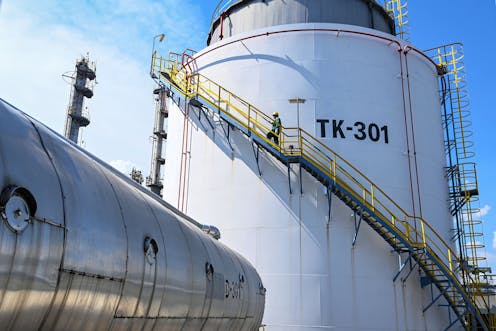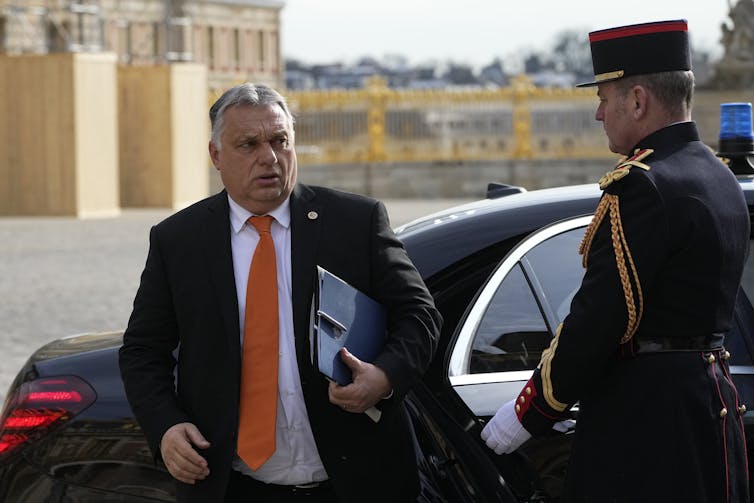
Russia’s invasion of Ukraine has forced Europe to rethink its energy policy – especially its deep dependence on Russia for about one-third of its fossil fuel imports. The European Union is negotiating among its members over a plan to ban imports of Russian oil, although questions remain about issues such as the timing of an embargo and what kinds of transactions it will cover. The EU makes decisions by consensus, so all members must agree for the plan to be adopted.
Russia exports large quantities of natural gas, coal, oil and fuel for nuclear reactors, but oil provides the most revenue. That income is financing Russia’s brutal war against Ukraine. Energy analysts estimate that every day Russia receives about 600 million euros (US$635 million) in income from its oil exports to western European countries.
I have studied post-Soviet energy for over 20 years. For my recent book, “Russian Energy Chains: The Remaking of Technopolitics from Siberia to Ukraine to the European Union,” I traced the journey of single molecules of crude oil, natural gas and coal from production in Siberia to their final use in Germany.
With the May 18, 2022 release of its RePowerEU plan for quickly reducing dependence on Russian fossil fuels, the EU has shown that it is determined to move forward. Yet from my research in oil trade in the region I know that important technical issues will affect Europe’s ability to quickly implement an embargo on Russian oil.
Not all oil is interchangeable
EU member states have been negotiating intensely over a proposed embargo for several months. Initially, Germany – the largest economy in the EU – opposed a ban. However, Germany dropped its objections in late April, and now says it will stop buying Russian oil by the end of 2022 even if the EU is unable to agree on a wider embargo.
Germany’s agreement left Hungary, Slovakia and the Czech Republic as the main holdouts. Some of this division reflects politics.
Hungary’s prime minister, Viktor Orban, has long criticized what he sees as excessive EU intervention in his country’s domestic politics. Orban has used good relations with Russian President Vladimir Putin as a counterweight to the EU, and has refused to support Ukraine in any real way as it defends itself against Russian aggression.

But Hungary, Slovakia and the Czech Republic also have legitimate energy and infrastructure concerns. Since the Soviet Union started exporting large quantities of crude oil to EU member states in the 1980s, oil has created a close and highly dependent relationship between Europe and Russia, particularly the former Soviet bloc countries.
Oil is not a generic product. Some types are sour, meaning that they have a high sulfur content, or sweet, meaning low in sulfur. Oil is also graded as light, which flows easily because it’s thinner and has less wax content, or dark, which contains more wax and is denser.
Sulfur is undesirable in gasoline and diesel fuel because it increases air pollution and makes vehicles’ catalytic converters less effective, so it needs to be removed during refining. Lighter oil with a low sulfur content, such as Brent crude oil from the North Sea, is easier to refine and thus commands higher prices.
Refineries are usually designed to process a particular type of oil. Russia exports mainly Urals oil, also known as Russian Export Blend Crude Oil or REBCO, a medium-sulfur oil blend. Refineries built during the Cold War in Soviet-bloc countries were designed to use it as a feedstock. And these countries, especially Hungary, have voiced the strongest concerns about a blanket Russian oil ban.
Cold War legacies
Energy transportation networks in these countries, as well as the former East Germany, also were put in place during the Cold War. Each country was set up to receive crude oil exclusively from Russia via the Druzhba pipeline, which began operating in 1964.
When the Soviet bloc broke apart in 1989 and 1990, former communist bloc countries – especially the land-locked Czech Republic, Slovakia and Hungary – were slow to develop infrastructure for importing oil via tanker because pipeline supplies from Russia were significantly cheaper. Moreover, it would have been difficult to retrofit their refineries to handle different types of oil from sources such as Saudi Arabia or the U.S.
These nations’ industrial and transportation sectors rely on gasoline and diesel produced in local refineries from Russian oil. And without ports, they have no ready way to receive oil shipments from elsewhere.
Given these challenges, it’s not surprising that Slovakia and the Czech Republic are seeking extra time beyond the end of 2022, the EU’s proposed deadline, for phasing out Russian oil imports. Bulgaria, citing similar refinery concerns, is also asking for an extension. And Hungary has demanded 15 billion to 18 billion euros ($16 billion to $19 billion) from the EU in economic compensation to retool its oil infrastructure – a figure that EU officials say is inflated.
Losing their energy chains
European dependence on Russian oil still runs deep. And even if EU countries agree on a ban, Russia will have other willing takers for this oil – notably India, the world’s third largest oil importer, which is already stocking up on Russian oil at significant discount prices relative to other oil types.
But the debate over a Russian oil embargo also has shown that the EU is not hostage to Russia. EU members have identified conventional and renewable energy sources that they can use to replace fossil fuels from Russia, at a projected cost of 210 billion euros ($220 billion) over the next five years.
And the EU has also shown that it can devise and reach basic consensus on new policies in record time. Its RePowerEU blueprint was developed in less than three months, and in a recent survey conducted in all EU member states, 85% of respondents supported reducing reliance on Russian fossil fuels. While it may be expensive to bring former Soviet bloc countries along, I expect this investment to pay off in the long term – not only in terms of increased independence from Russian fossil fuels, but, even more importantly, in terms of moving away from fossil fuels as a whole.
Margarita Balmaceda has received funding from the Alexander von Humboldt Foundation, the European Consortium of Institutes of Advanced Studies and the Woodrow Wilson International Center for Scholars. She chairs the Academic Advisory Board of the Research Centre for East European Studies at the University of Bremen and serves on the Scientific Advisory Board of the Centre for East European and International Studies in Berlin and the Board of the Schevchenko Scientific Society of the USA.
This article was originally published on The Conversation. Read the original article.







